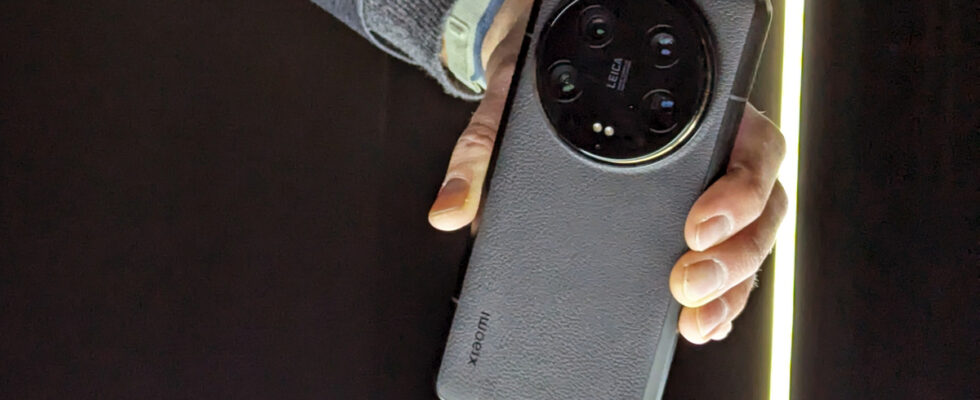Xiaomi 14 Ultra
In the absence of offers discover
The links shown above may not work in the presence of an ad blocker.
The first models priced in the “Ultra” version had not crossed Chinese borders, even though the 12S Ultra was the first camera to benefit from its partnership with Leica. Xiaomi tried it in 2023 with the 13 Ultra, marketed in Europe in small quantities, and is now going all out. Its 14 Ultra is coming to the Old Continent and testifies to the brand’s desire to gain legitimacy in the high-end segment.
To seduce, the Xiaomi 14 Ultra pulls out all the stops. First in terms of design: it presents a neat case, certified IP68, which even offers a variation with a titanium frame, and whose back is glazed or covered in imitation leather. its little effect. Xiaomi uses, for its glass model, a protection called Dragon Crystal which we hope will be as resistant as the Gorilla Glass used by most competing brands, and which testifies to its desire to develop more and more elements internally – this is particularly the case of the Ligh Fusion 900 photo sensor integrated into the Xiaomi 14 .
This back houses a very imposing photo block, even larger than that of the 13 Ultra. Suffice it to say that image capture is more than ever at the heart of the subject.
A fearsomely bright screen
On the front, the smartphone presents an uncompromising screen. There is a 6.73-inch panel displaying 3200 x 1440 pixels, or a resolution of 522 ppi. Xiaomi announces a maximum brightness of 3000 cd/m² peak, the same value as that of the model 14, which has proven capable of reaching 1500 cd/m² under standard conditions; there is no doubt that the 14 Ultra achieves comparable brightness. If it does not fundamentally review the design of its 13 Ultra with this new generation, Xiaomi embraces the trends of the moment: there is therefore no longer any question of a curved screen, but of a flat panel which seems to float on the chassis of the smartphone, hence its little name Liquid Display. Its edges have been refined along the way, particularly at the corners of the device.
Behind this cover hides a Snapdragon 8 Gen 3 chip flanked by 16 GB of RAM (and 512 GB of storage, in its only version sold in France): suffice to say that this equipment does not raise any concerns on our side, and it has the merit of providing support for wifi 7 and Bluetooth 5.4. Same thing on the battery side: the 5000 mAh retained should be enough to give it good endurance, which we will of course check in the laboratory. Note that fast charging is included, at 90 W wired (Xiaomi announces a full charge in 33 minutes) and 80 W wireless.
Everything for photography (and video)
The photo niche long occupied by Huawei finally remained vacant. It is the place of manufacturer targeting users looking for a tool capable of taking pretty photos on a daily basis, and beautiful images when they want to take better care of their productions, that Xiaomi intends to invest.
The equipment on board its 14 Ultra is intended to be at the cutting edge of current technologies. The 1-inch Sony IMX989 sensor in the 13 Ultra is replaced by Sony’s latest sensor, the LYT-900, which we haven’t had the opportunity to test yet but which we have heard about during the presentation of the Oppo Find X7 Ultra – which is not sold in France. This 50 megapixel model, still one inch, is accompanied by Summilux optics developed by Leica, with eight elements, and above all with variable aperture (between f/1 .63 and f/4) continuously, not just in increments.
This module is completed by an ultra wide-angle (f/1.8) based on a Sony IMX858 sensor, and has autofocus; it also allows you to take macro photos from 5 cm. Magnification is also in the spotlight, thanks to another 50 Mpx IMX858 associated with stabilized optics equivalent to 75 mm (x3.2 zoom) and aperture at f/1.8; it allows macro from 10 cm. A fourth module, also with a 50 Mpx sensor (don’t look for its reference, it’s again the IMX858), this time gains an equivalent periscopic optic at 120 mm (f/2.5, OIS), i.e. 5x magnification, usable in macro from 30 cm. AI scene recognition models accompany all of this to “fine-tune image quality“, according to the brand.
The Chinese manufacturer also hopes to seduce with its video service. 4K HDR filming modes and 10-bit LOG exploitation are notably on the menu; the tests that we were able to observe show the interest of such a smartphone for those who intend to use it in the context of careful video productions. If the use seems a little too specific to reach the general public, we note on the other hand the presence of a Director mode, easily accessible Pro settings, or even cropping automatic (by AI, ensures the brand) around the subject of the video.
This photo equipment, associated with an otherwise premium smartphone, justifies a high price, but which at least has not increased if we compare it to that of the 13 Ultra. Still count on €1,499 for the device offered in 16/512 GB, which places it in the price range of prestigious competitors, such as Samsung’s Galaxy S24 Ultra and Apple’s iPhone 15 Pro Max. It will be available from 19 2024, and will be released under Hyper OS, associated with Android 14; a very photo kit (with grip and filter support) worth €199 will be offered with the camera for any purchase until April 30.
